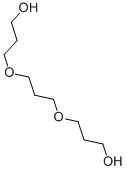Tripropylene glycol
Synonym(s):[(1-Methyl-1,2-ethanediyl)bis(oxy)]bispropanol
- CAS NO.:24800-44-0
- Empirical Formula: C9H20O4
- Molecular Weight: 192.25
- MDL number: MFCD00014405
- EINECS: 246-466-0
- SAFETY DATA SHEET (SDS)
- Update Date: 2024-12-18 14:08:52

What is Tripropylene glycol?
Chemical properties
Tripropylene glycol is a water-white liquid. Soluble in water, methanol, ether. Combustible. One of its unique features is its combination of water-solubility and good solubility for many organic compounds. Because of high boiling point and low volatility it is used in the formulation of textile soaps, lubricants, cutting oils, and similar applications.
The Uses of Tripropylene glycol
Tripropylene glycol is used for textile soaps, lubricants, cutting oils and greases. It acts as an intermediate in the preparation of urethanes. It is also used as a solvent in coatings and inks. It is utilized as varnish removers, emulsifiers and hydraulic fluids. As an additive, it is used for carburetor fuels. It is involved as a cooling media as well as an active ingredient of plasticizers.
The Uses of Tripropylene glycol
Intermediate in resins, plasticizers, pharmaceuticals, insecticides, dyestuffs, mold lubricants.
Reactivity Profile
Tripropylene glycol is a ether-alcohol derivative. The ether being relatively unreactive. Flammable and/or toxic gases are generated by the combination of alcohols with alkali metals, nitrides, and strong reducing agents. They react with oxoacids and carboxylic acids to form esters plus water. Oxidizing agents convert alcohols to aldehydes or ketones. Alcohols exhibit both weak acid and weak base behavior. They may initiate the polymerization of isocyanates and epoxides. May attack some forms of plastics [USCG, 1999].
Health Hazard
Non-irritating; no symptoms observed by any exposure route.
Fire Hazard
Special Hazards of Combustion Products: Acrid fumes of acids and aldehydes may form in fires.
Flammability and Explosibility
Non flammable
Chemical Reactivity
Reactivity with Water No reaction; Reactivity with Common Materials: May attack some forms of plastics and elastomers; Stability During Transport: Stable; Neutralizing Agents for Acids and Caustics: Not pertinent; Polymerization: Not pertinent; Inhibitor of Polymerization: Not pertinent.
Properties of Tripropylene glycol
| Melting point: | -45°C |
| Boiling point: | 273 °C (lit.) |
| Density | 1.021 g/mL at 25 °C (lit.) |
| vapor density | 6.63 (vs air) |
| vapor pressure | <0.01 mm Hg ( 25 °C) |
| refractive index | n |
| Flash point: | >230 °F |
| form | Liquid |
| color | Colorless to Light yellow |
| Specific Gravity | 1.018 |
| Odor | Characteristic. |
| Water Solubility | Miscible with water, methanol and ether. |
| BRN | 2235421 |
| CAS DataBase Reference | 24800-44-0(CAS DataBase Reference) |
| EPA Substance Registry System | Tripropylene glycol (24800-44-0) |
Safety information for Tripropylene glycol
| Signal word | Warning |
| Pictogram(s) |
 Exclamation Mark Irritant GHS07 |
| GHS Hazard Statements |
H303:Acute toxicity,oral H315:Skin corrosion/irritation H319:Serious eye damage/eye irritation |
| Precautionary Statement Codes |
P264:Wash hands thoroughly after handling. P264:Wash skin thouroughly after handling. P280:Wear protective gloves/protective clothing/eye protection/face protection. |
Computed Descriptors for Tripropylene glycol
New Products
Tert-butyl bis(2-chloroethyl)carbamate 4-Methylphenylacetic acid N-Boc-D-alaninol N-BOC-D/L-ALANINOL N-octanoyl benzotriazole 3-Morpholino-1-(4-nitrophenyl)-5,6-dihydropyridin- 2(1H)-one Furan-2,5-Dicarboxylic Acid DIETHYL AMINOMALONATE HYDROCHLORIDE 1,1’-CARBONYLDIIMIDAZOLE R-2-BENZYLOXY PROPIONIC ACID 1,1’-CARBONYLDI (1,2-4 TRIAZOLE) N-METHYL INDAZOLE-3-CARBOXYLIC ACID (2-Hydroxyphenyl)acetonitrile 4-Bromopyrazole 5-BROMO-2CYANO PYRIDINE 5,6-Dimethoxyindanone 5-broMo-2-chloro-N-cyclopentylpyriMidin-4-aMine 2-(Cyanocyclohexyl)acetic acid 4-methoxy-3,5-dinitropyridine 1-(4-(aminomethyl)benzyl)urea hydrochloride 2-aminopropyl benzoate hydrochloride diethyl 2-(2-((tertbutoxycarbonyl)amino) ethyl)malonate tert-butyl 4- (ureidomethyl)benzylcarbamate Ethyl-2-chloro((4-methoxyphenyl)hydrazono)acetateRelated products of tetrahydrofuran








You may like
-
 Tripropylene glycol CAS 24800-44-0View Details
Tripropylene glycol CAS 24800-44-0View Details
24800-44-0 -
 Tripropylene glycol CAS 24800-44-0View Details
Tripropylene glycol CAS 24800-44-0View Details
24800-44-0 -
 Tripropylene Glycol (mixture of isomers) CAS 24800-44-0View Details
Tripropylene Glycol (mixture of isomers) CAS 24800-44-0View Details
24800-44-0 -
 Tripropylene glycol CAS 24800-44-0View Details
Tripropylene glycol CAS 24800-44-0View Details
24800-44-0 -
 1975-50-4 98%View Details
1975-50-4 98%View Details
1975-50-4 -
 14714-50-2 (2-Hydroxyphenyl)acetonitrile 98+View Details
14714-50-2 (2-Hydroxyphenyl)acetonitrile 98+View Details
14714-50-2 -
 118753-70-1 98+View Details
118753-70-1 98+View Details
118753-70-1 -
 733039-20-8 5-broMo-2-chloro-N-cyclopentylpyriMidin-4-aMine 98+View Details
733039-20-8 5-broMo-2-chloro-N-cyclopentylpyriMidin-4-aMine 98+View Details
733039-20-8